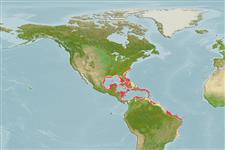Teleostei (teleosts) >
Eupercaria/misc (Various families in series Eupercaria) >
Labridae (Wrasses) > Corinae
Etymology: Halichoeres: Greek, als, alis = salt + Greek, choiros = pig (Ref. 45335).
More on author: Linnaeus.
Environment: milieu / climate zone / depth range / distribution range
Ecology
Marine; brackish; reef-associated; depth range 2 - 55 m (Ref. 9710), usually 5 - 45 m (Ref. 27115). Tropical; 23°C - 27°C (Ref. 27115); 37°N - 19°S, 98°W - 28°W
Western Atlantic: Bermuda, throughout the West Indies, Florida, the Carolinas, and Gulf of Mexico; found at the Brazilian oceanic islands of St. Paul's Rocks, Fernando de Noronha and Atol das Rochas. Does not co-occur with H. brasiliensis in Brazilian coastal waters.
Size / Weight / Age
Maturity: Lm ? range ? - ? cm
Max length : 51.0 cm TL male/unsexed; (Ref. 7251); common length : 40.0 cm TL male/unsexed; (Ref. 5217)
Dorsal
spines
(total): 9;
Dorsal
soft rays
(total): 11;
Anal
spines: 3;
Anal
soft rays: 12. Two pairs of enlarged canines in lower jaw; anterior lateral line scales with 3 or more pores per scale; body depth 2.7-3.6 in SL; distinctive 4 or 5 narrow pale bars along the dorsum, more evident in specimens up to 20 cm SL; yellow margin on caudal fin (Ref. 48669).
Adults found on shallow patch or seaward reefs down to 55 m (Ref. 9710); juveniles and subadults in shallower (1 to 5 m) coral reefs (Ref. 3726). Feeds on mollusks, sea urchins, crustaceans, and brittle stars (Ref. 9710). Marketed fresh (Ref. 3726).
Life cycle and mating behavior
Maturity | Reproduction | Spawning | Eggs | Fecundity | Larvae
Robins, C.R. and G.C. Ray, 1986. A field guide to Atlantic coast fishes of North America. Houghton Mifflin Company, Boston, U.S.A. 354 p. (Ref. 7251)
IUCN Red List Status (Ref. 130435)
Threat to humans
Reports of ciguatera poisoning (Ref. 30303)
Human uses
Fisheries: minor commercial; aquarium: commercial
More information
Common namesSynonymsMetabolismPredatorsEcotoxicologyReproductionMaturitySpawningSpawning aggregationFecundityEggsEgg development
ReferencesAquacultureAquaculture profileStrainsGeneticsElectrophoresesHeritabilityDiseasesProcessingNutrientsMass conversion
Tools
Special reports
Download XML
Internet sources
Estimates based on models
Preferred temperature (Ref.
123201): 24 - 28, mean 26.8 °C (based on 406 cells).
Phylogenetic diversity index (Ref.
82804): PD
50 = 0.5000 [Uniqueness, from 0.5 = low to 2.0 = high].
Bayesian length-weight: a=0.00955 (0.00451 - 0.02020), b=3.09 (2.92 - 3.26), in cm total length, based on LWR estimates for this Genus-body shape (Ref.
93245).
Trophic level (Ref.
69278): 3.5 ±0.1 se; based on diet studies.
Resilience (Ref.
120179): Low, minimum population doubling time 4.5 - 14 years (Preliminary K or Fecundity.).
Fishing Vulnerability (Ref.
59153): Moderate vulnerability (40 of 100).
Nutrients (Ref.
124155): Calcium = 36.5 [21.1, 60.5] mg/100g; Iron = 0.503 [0.295, 0.906] mg/100g; Protein = 18.8 [16.0, 21.0] %; Omega3 = 0.144 [0.095, 0.215] g/100g; Selenium = 32.8 [19.4, 53.6] μg/100g; VitaminA = 84.9 [25.1, 324.7] μg/100g; Zinc = 1.43 [1.04, 2.28] mg/100g (wet weight);
